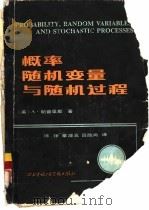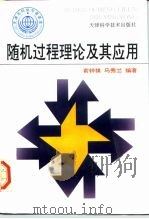《introduction to probability models = 应用随机过程 概率模型导论 P780》
| 作者 | 编者 |
|---|---|
| 出版 | 未查询到或未知 |
| 参考页数 | |
| 出版时间 | 没有确切时间的资料 目录预览 |
| ISBN号 | 无 — 求助条款 |
| PDF编号 | 820576758(仅供预览,未存储实际文件) |
| 求助格式 | 扫描PDF(若分多册发行,每次仅能受理1册) |

1.Introduction to Probability Theory1
1.1.Introduction1
1.2.Sample Space and Events1
1.3.Probabilities Defined on Events4
1.4.Conditional Probabilities7
1.5.Independent Events10
1.6.Bayes' Formula12
Exercises15
References21
2.Random Variables23
2.1.Random Variables23
2.2.Discrete Random Variables27
2.2.1.The Bernoulli Random Variable28
2.2.2.The Binomial Random Variable29
2.2.3.The Geometric Random Variable31
2.2.4.The Poisson Random Variable32
2.3.Continuous Random Variables34
2.3.1.The Uniform Random Variable35
2.3.2.Exponential Random Variables36
2.3.3.Gamma Random Variables37
2.3.4.Normal Random Variables37
2.4.Expectation of a Random Variable38
2.4.1.The Discrete Case38
2.4.2.The Continuous Case41
2.4.3.Expectation of a Function of a Random Variable43
2.5.Jointly Distributed Random Variables47
2.5.1.Joint Distribution Functions47
2.5.2.Independent Random Variables51
2.5.3.Covariance and Variance of Sums of Random Variables53
2.5.4.Joint Probability Distribution of Functions of Random Variables61
2.6.Moment Generating Functions64
2.6.1.The Joint Distribution of the Sample Mean and Sample Variance from a Normal Population74
2.7.Limit Theorems77
2.8.Stochastic Processes83
Exercises85
References96
3.Conditional Probability and Conditional Expectation97
3.1.Introduction97
3.2.The Discrete Case97
3.3.The Continuous Case102
3.4.Computing Expectations by Conditioning105
3.4.1.Computing Variances by Conditioning117
3.5.Computing Probabilities by Conditioning120
3.6.Some Applications137
3.6.1.A List Model137
3.6.2.A Random Graph139
3.6.3.Uniform Priors, Polya's Urn Model, and Bose-Einstein Statistics147
3.6.4.Mean Time for Patterns151
3.6.5.The k-Record Values of Discrete Random Variables155
3.7.An Identity for Compound Random Variables158
3.7.1.Poisson Compounding Distribution161
3.7.2.Binomial Compounding Distribution163
3.7.3.A Compounding Distribution Related to the Negative Binomial164
Exercises165
4.Markov Chains185
4.1.Introduction185
4.2.Chapman-Kolmogorov Equations189
4.3.Classification of States193
4.4.Limiting Probabilities204
4.5.Some Applications217
4.5.1.The Gambler's Ruin Problem217
4.5.2.A Model for Algorithmic Efficiency221
4.5.3.Using a Random Walk to Analyze a Probabilistic Algorithm for the Satisfiability Problem224
4.6.Mean Time Spent in Transient States230
4.7.Branching Processes233
4.8.Time Reversible Markov Chains236
4.9.Markov Chain Monte Carlo Methods247
4.10.Markov Decision Processes252
4.11.Hidden Markov Chains256
4.11.1.Predicting the States261
Exercises263
References280
5.The Exponential Distribution and the Poisson Process281
5.1.Introduction281
5.2.The Exponential Distribution282
5.2.1.Definition282
5.2.2.Properties of the Exponential Distribution284
5.2.3.Further Properties of the Exponential Distribution291
5.2.4.Convolutions of Exponential Random Variables298
5.3.The Poisson Process302
5.3.1.Counting Processes302
5.3.2.Definition of the Poisson Process304
5.3.3.Interarrival and Waiting Time Distributions307
5.3.4.Further Properties of Poisson Processes310
5.3.5.Conditional Distribution of the Arrival Times316
5.3.6.Estimating Software Reliability328
5.4.Generalizations of the Poisson Process330
5.4.1.Nonhomogeneous Poisson Process330
5.4.2.Compound Poisson Process337
5.4.3.Conditional or Mixed Poisson Processes343
Exercises346
References364
6.Continuous-Time Markov Chains365
6.1.Introduction365
6.2.Continuous-Time Markov Chains366
6.3.Birth and Death Processes368
6.4.The Transition Probability Function Pij (t)375
6.5.Limiting Probabilities384
6.6.Time Reversibility392
6.7.Uniformization401
6.8.Computing the Transition Probabilities404
Exercises407
References415
7.Renewal Theory and Its Applications417
7.1.Introduction417
7.2.Distribution of N(t)419
7.3.Limit Theorems and Their Applications423
7.4.Renewal Reward Processes433
7.5.Regenerative Processes442
7.5.1.Alternating Renewal Processes445
7.6.Semi-Markov Processes452
7.7.The Inspection Paradox455
7.8.Computing the Renewal Function458
7.9.Applications to Patterns461
7.9.1.Patterns of Discrete Random Variables462
7.9.2.The Expected Time to a Maximal Run of Distinct Values469
7.9.3.Increasing Runs of Continuous Random Variables471
7.10.The Insurance Ruin Problem473
Exercises479
References492
8.Queueing Theory493
8.1.Introduction493
8.2.Preliminaries494
8.2.1.Cost Equations495
8.2.2.Steady-State Probabilities496
8.3.Exponential Models499
8.3.1.A Single-Server Exponential Queueing System499
8.3.2.A Single-Server Exponential Queueing System Having Finite Capacity508
8.3.3.A Shoeshine Shop511
8.3.4.A Queueing System with Bulk Service514
8.4.Network of Queues517
8.4.1.Open Systems517
8.4.2.Closed Systems522
8.5.The System M/ G/ 1528
8.5.1.Preliminaries: Work and Another Cost Identity528
8.5.2.Application of Work to M/G/1529
8.5.3.Busy Periods530
8.6.Variations on the M/G/1531
8.6.1.The M/G/1 with Random-Sized Batch Arrivals531
8.6.2.Priority Queues533
8.6.3.An M/ G/ 1 Optimization Example536
8.6.4.The M/ G/ 1 Queue with Server Breakdown540
8.7.The Model G/M/1543
8.7.1.The G/M/1 Busy and Idle Periods548
8.8.A Finite Source Model549
8.9.Multiserver Queues552
8.9.1.Erlang's Loss System553
8.9.2.The M/M/k Queue554
8.9.3.The G/M/k Queue554
8.9.4.The M/G/k Queue556
Exercises558
References570
9.Reliability Theory571
9.1.Introduction571
9.2.Structure Functions571
9.2.1.Minimal Path and Minimal Cut Sets574
9.3.Reliability of Systems of Independent Components578
9.4.Bounds on the Reliability Function583
9.4.1.Method of Inclusion and Exclusion584
9.4.2.Second Method for Obtaining Bounds on r (p)593
9.5.System Life as a Function of Component Lives595
9.6.Expected System Lifetime604
9.6.1.An Upper Bound on the Expected Life of aParallel System608
9.7.Systems with Repair610
9.7.1.A Series Model with Suspended Animation615
Exercises617
References624
10.Brownian Motion and Stationary Processes625
10.1.Brownian Motion625
10.2.Hitting Times, Maximum Variable, and the Gambler's Ruin Problem629
10.3.Variations on Brownian Motion631
10.3.1.Brownian Motion with Drift631
10.3.2.Geometric Brownian Motion631
10.4.Pricing Stock Options632
10.4.1.An Example in Options Pricing632
10.4.2.The Arbitrage Theorem635
10.4.3.The Black-Scholes Option Pricing Formula638
10.5.White Noise644
10.6.Gaussian Processes646
10.7.Stationary and Weakly Stationary Processes649
10.8.Harmonic Analysis of Weakly Stationary Processes654
Exercises657
References662
11.Simulation663
11.1.Introduction663
11.2.General Techniques for Simulating Continuous Random Variables668
11.2.1.The Inverse Transformation Method668
11.2.2.The Rejection Method669
11.2.3.The Hazard Rate Method673
11.3.Special Techniques for Simulating Continuous Random Variables677
11.3.1.The Normal Distribution677
11.3.2.The Gamma Distribution680
11.3.3.The Chi-Squared Distribution681
11.3.4.The Beta (n, m) Distribution681
11.3.5.The Exponential Distribution—The Von Neumann Algorithm682
11.4.Simulating from Discrete Distributions685
11.4.1.The Alias Method688
《introduction to probability models = 应用随机过程 概率模型导论 P780》由于是年代较久的资料都绝版了,几乎不可能购买到实物。如果大家为了学习确实需要,可向博主求助其电子版PDF文件。对合法合规的求助,我会当即受理并将下载地址发送给你。
高度相关资料
-

- 应用随机过程引论
- 1984 哈尔滨:哈尔滨工业大学出版社
-

- 概率论与随机过程
- 1999年12月第1版 东南大学出版社
-

- 概率论基础 随机过程通论
- 1977
-

- 概率论及随机过程在海军的应用
- 1983.02
-

- 概率随机变量与随机过程 1984年版
- 1986 西北电讯工程学院出版社
-

- 概率、随机变量与随机过程
- 1983 北京:高等教育出版社
-

- 概率论 第3册 随机过程
- 1981 北京:人民教育出版社
-

- 随机过程理论与应用
- 1991 北京:国防工业出版社
-

- 随机过程的应用
- 1962 科学技术出版社
-

- 模糊随机过程论
- 1994 贵阳:贵州科技出版社
-

- 概率论与随机过程
- 1996 北京:人民邮电出版社
-

- 概率论基础和随机过程
- 1986 北京:科学出版社
-

- 随机过程理论及其应用
- 1996 天津:天津科学技术出版社
-

- 概率、随机变量与随机过程
- 1989 北京:北京航空航天大学出版社
提示:百度云已更名为百度网盘(百度盘),天翼云盘、微盘下载地址……暂未提供。➥ PDF文字可复制化或转WORD
